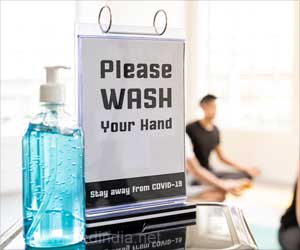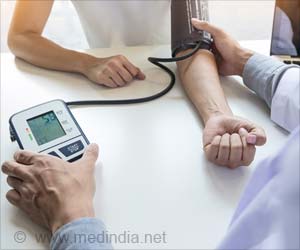Sample studies were conducted in various parts of the world and steps were taken toward quantifying the
at gyms and fitness clubs. This study was published in the journal
and expelled it into a plastic bag, thus removing sources of contamination, said Prof. Christian Kähler at the Institute of Fluid Mechanics and Aerodynamics at Universität der Bundeswehr München and co-author of the study to Time. Their aerosol particle production was measured while at rest and working on themselves.
The study found that participants inhaled approximately 580 particles per minute at rest and 76,200 particles per minute during strenuous exercise. Those with more experience in high-level fitness and endurance training inhaled 85% more aerosols than those without such training ().
Advertisement
“This information should be used to develop more data-based mitigation measures for indoor group exercise,” the study authors said.
They recommended increasing ventilation to the gym, keeping a safe distance between exercisers, and controlling the time spent in the gym ().
In addition, 15-minute broadcast breaks between classes, pre-participant exercise screening, protective shielding between exercisers, air filters and wearing a mask during exercise are recommended ().
“These data not only explain SARS-CoV-2 transmissions during indoor group exercise but also can be used to design better targeted mitigation measures for physical activity indoors such as physical education in school, dance events during weddings or high-intensity gym classes such as spinning,” the study says.
The researchers said that there were several limitations to their study. Only 16 people participated and none of them had COVID, so the true distribution of the COVID aerosol particles was not calculated ().
Research Study in South Korea
A research study in South Korea examined the number of aerosol particles emitted by people during rest and exercise. These tiny airborne objects a few hundred micrometers in diameter or the width of a hair and suspended in the fog from our lungs can carry the COVID lightly in the air if anyone is infected from one pair of lungs to another.
The study found that men and women breathe about 500 particles per minute at rest. But when they exercised the total increased 132 times averaging over 76,000 ppm during the most strenuous work ().
In general, clogging hard breathing bodies in closed areas is a bad way to prevent the spread of COVID-19 or other respiratory diseases. In 2020, 54 South Koreans developed COVID after Zumba classes with affected instructors and then passed it on to their family members and acquaintances. Later that year, all 10 members of the Hawaii spin class taught by the affected instructor tested positive and 11 came into close contact with one of the class members, a personal trainer, and a kickboxing instructor.
Scientists who have studied these and similar eruptions have speculated that inadequate ventilation and high respiration rates among exercisers may have contributed to the spread of COIVD ‘wildfires’ in the affected gyms. But scientists could only guess to what extent exercise in gym areas increased the amount of the aerosol particles. It is difficult to accurately measure the elevation of floating particles during exercise.
More Aerosol Emission During High-Intensity Exercise
Prof. Henning Wackerhage at Technische Universität München and a co-author of the study said, “We knew before that when you exercise, there’s more air coming out of a person.” He adds, “But we didn’t know before, and which, quite frankly, I didn’t expect, is that also when we exercise hard: there are more particles per liter of air.”
The study authors were able to determine the amount of particles that have been released at rest and during an exercise routine.
For another study, the researchers asked 16 participants to breath in clean air from a silicone mask and then breath out into a plastic bag. According to Prof. Kähler, this has led to more accurate results.
Those who were physically fit were found to emit 85% more aerosol particles than those who were not physically fit. Regular trainers and exercisers are more likely to release large amounts of aerosol particles which may indicate a higher risk of infection.
How to Reduce the Risk at Gyms?
Since the onset of the COVID-19 pandemic experts have repeatedly emphasized the importance of wearing masks, maintaining social space, and adhering to proper hand hygiene. This goes for those who come to the gym and handle the equipment.
Following are six ways to protect your health as well as the health of your fellow gym-users.
Not Going to Gym during Peak Hours
COVID-19 primarily spreads from person-to-person through respiratory droplets. This means that one of the best ways to avoid COVID-19 is through social distancing which includes avoiding crowds.
The best way to reduce the chance of contact with someone suffering from COVID-19 while at the gym is to go during times when there are fewer people. If you do not know the peak hours of your gym, call them. Additionally, some smartphone map apps list popular times of the location and whether it is currently busy or not ().
Avoid Areas With Crowded Equipment
Social exclusion is also the avoidance of close contact with others. Remember, “close” may be farther away than you initially thought. To protect yourself from COVID-19 the CDC recommends keeping six feet between yourself and others.
You may want to use equipment that provides enough space between you and other gym users this can sometimes be difficult. Also, keep in mind that the CDC does not recommend attending indoor, high-intensity fitness classes unless you are vaccinated ().
Wipe Every Piece of Equipment You Use
Evidence suggests that the new COVID-19 virus may live anywhere on the surface for hours to several days. This means it is important to clean and disinfect every appliance you use.
If you are not vaccinated you may want to consider avoiding commonly used equipment such as barbells, dumbbells, treadmills, elliptical trainers, and yoga and stretch mats especially if they seem difficult to clean and wipe ().
Wash Your Hands and Avoid Touching Your Face
Practice regular hand washing before and after your workout. You may also want to consider using a hand cleanser from time to time throughout your workout.
Lastly, although it can be difficult to do this when you are sweating, avoid touching your face especially your eyes, nose, and mouth. These are the three main entry points for respiratory viruses such as the new COVID-19 virus and its variants ().
Stay Home If You’re Sick
As with any infectious illness it is recommended that you stay home as much as possible if you suspect you’re sick even if you’re vaccinated.
Alternatives to Gym Preference
During COVID-19 pandemic the government has issued instructions that gyms and fitness centers have to follow. You can make your house a gym.
Get your own workout equipment and train at home. Other than that you can indulge in bodyweight exercises that have almost the same benefits but with less risks. Additionally, regular walks out in fresh air and yoga can improve your overall health.
To avoid the risk of COVID-19 infection you can also resort to home workouts.
References :
- Why gyms have a higher risk of COVID – (https://www.news-medical.net/news/20220526/Why-gyms-have-a-higher-risk-of-COVID.aspx)
- Cluster of Coronavirus Disease Associated with Fitness Dance Classes, South Korea – (https://pubmed.ncbi.nlm.nih.gov/32412896/)
- COVID-19: Is It Safe to Go Back to the Gym? – (https://www.houstonmethodist.org/blog/articles/2020/mar/coronavirus-is-it-safe-to-go-to-the-gym/)
Source: Medindia



